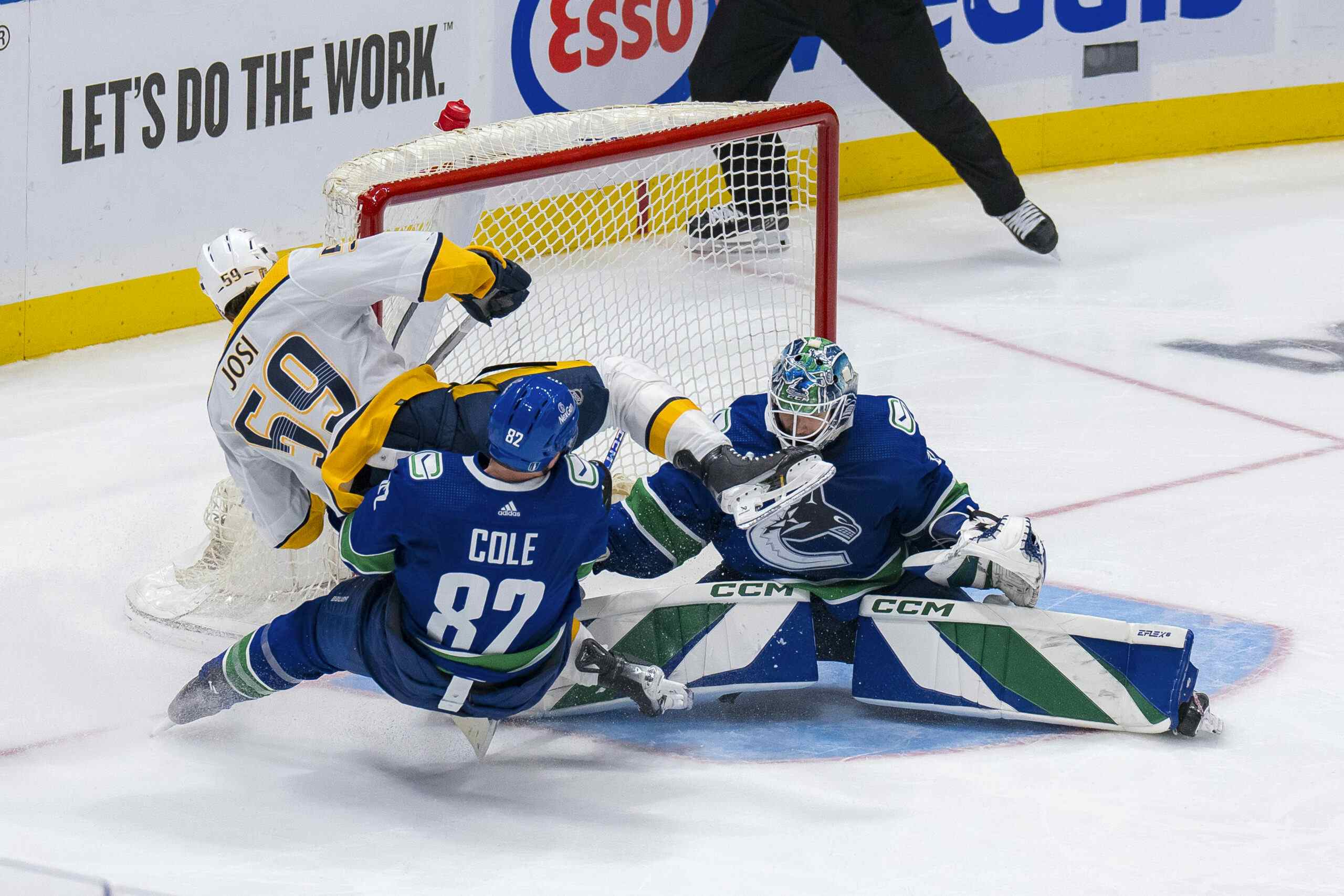What Zone Data in Penticton tells us about Vancouver’s Prospects
By Josh W
8 years ago
Cole Cassels with a successful pass in entry to Hunter Shinkaruk
A little over a week ago, the Canucks Young Stars tournament in Penticton wrapped up. It was a fun one, in the sense that we got our first chance to see many of the Canucks prospects in what we hope will become their eventual uniforms for the first time.
Now that it’s over, however, I took the opportunity to go back and re-analyze the games. With this, I’ve compiled some zone entry data to share with you all. The sample is small; just three games, but it’s better than nothing. We gave a glimpse into some of the data in a post last week, but now that all the game data has been amalgamated, we can get a better picture of how these prospects performed over the weekend.
Background
Talk of zone entries is a rare occurrence on Canucks Army. After all, we’re a bunch of nerds who only read stats. We don’t play the game, and to be honest, we don’t watch the games either. Unless you have access to advanced (and expensive) technology, zone entries (and other micro-stats) require manual tracking, which means that you to watch the game; expecting us to do that would be insane.
There has been an increased emphasis on zone entries in the analytics community over the past couple of years, largely thanks to a collaborative research paper spearheaded by present-day Carolina Hurricanes employee Eric Tulsky. While the value of shot-based possession numbers in predicting future wins had become established at this point, the research was a first step in micro-statistics that attempted to explain the “how” to the prior work’s “what”.
In layman’s terms, the study showed that teams that entered into an attacking position while carrying or passing the puck were much more likely to generate shots, leading to higher possession numbers. In turn, this leads to more goals, which leads to more wins. The opposite proved to be true as well; teams that employed a dump-and-chase driven breakout were less likely to create offensive opportunities.
Zone entries are the most popular of the present micro-statistics, but many are looking towards other methods of determining pace, control, and momentum of the game. Passing, while more difficult to track manually, is another metric on the rise, and one that we’re looking to spend some time on at Canucks Army this year.
Young Stars
With all of this said, let’s take a look at how the Canucks prospects did in Penticton, specifically from a zone entry perspective. The following stats only involve even-strength situations.
Zone Entries

Offensive Zone Entries occur when a player intentionally brings the puck into the offensive zone from the neutral zone. The players who have the most opportunities are typically the ones who are given the most ice time. As well, the players who have the most offensive zone entries tend to be the ones leaned on to generate offence; obviously, forwards will dominate in the charts in this regard.
More than anything, we’re looking for players who can consistently move the puck into the offensive zone without giving it up, as it allows them to turn their possession into an opportunity. Unsurprisingly, the players with a combination of high frequency and success are among Vancouver’s top prospects, and defencemen dominate the bottom of the list.
- Jake Virtanen was frequently relied upon to bring the puck into the offensive zone. Ice time plays a big part in this, but his strong skating ability also allows for him to rush the puck into the zone better than most in his class. As a result, he converted on almost all of his opportunities, most of which came from carry-ins. Only 1 in 20 was a dump in.
- Hunter Shinkaruk was in a very similar boat, having even more opportunities than Virtanen and converting at a similar if slightly less successful rate.
- Jarred McCann, Joe LaBate, Rodrigo Abols and Brendan Gaunce weren’t in the same tier as the aforementioned Virtanen and Shinkaruk, but took advantage of the opportunities that they had and were quite successful one the puck was on their stick.
- Jordan Subban’s abilities at as an offensive defenceman were on display here; despite his less-than advantageous position, he was still able to create more offensive zone time for the Canucks than many of the team’s forwards.
- Dane Fox didn’t have a ton of opportunity to involve himself with the play. With that said, he did a very solid job when those chances came.
- The bottom of this list consists of defencemen or lower tier prospects; while one dreams of top-to-bottom dominance, it’s not overly alarming to see this group where they are.
Zone Exits

Zone Exits rely on the same core concepts as entries. They involve moving the puck out of your team’s defensive zone and into neutral ice, which limits opportunities against you while allowing your teammates to create chances of their own. Since they involve the other side of the ice, exit numbers are typically dominated by defencemen, though some coaches might use a system that involves a carrying forward.
- Once again, we see Hunter Shinkaruk, Jordan Subban, and Jake Virtanen near the top of the list. This is a very positive sign, as it displays a “two hundred foot game” in an objective sense, while making the team more likely to be successful.
- Cole Cassels ranks higher on this list than he did with his entries, which makes a lot of sense, given his use in defensive situations. The best two-way forwards are the ones who find themselves at the top of both lists, but being strong at exits should be the bare minimum for a “shutdown” forward.
- Jared McCann’s success rate slightly, while some of the guys who were good at entries were not good at exits including Brendan Gaunce, Rodrigo Abols and Dane Fox. With that said, the sample size that we’re dealing with when it comes to these four is smaller than small, and might play a factor.
- While Subban was the standout player on the point, Ben Hutton definitely deserves some recognition for being good at both ends of the rink. Guillaume Brisebois’s entry numbers weren’t anything to phone home about, but his exit statistics are promising.
While this is all very interesting data, it’s worth keeping in mind that we’re dealing with a sample of two to three games; hardly definitive research for any of the players. With that said, a small sample is still better than nothing, and in the right context could be layered with other data or “eyeball” perceptions. Besides, even if the sample is too small to judge the future of these players, it’s certainly big enough to make conclusions on who contributed the most over those few games. We’ll be doing our best to build on this data over the course of the AHL season, and hopefully re-visit the performance of many of the players in this group.
Recent articles from Josh W





